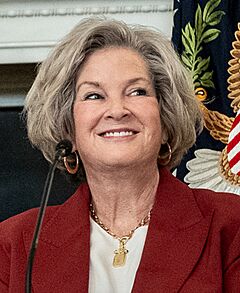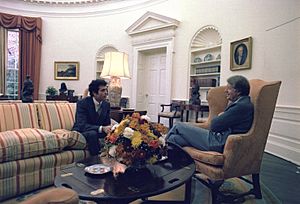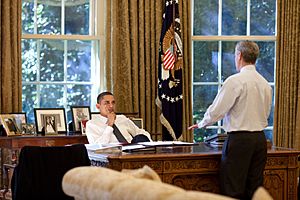White House Chief of Staff facts for kids
Quick facts for kids White House Chief of Staff |
|
|---|---|
 |
|
| White House Office Executive Office of the President |
|
| Reports to | President of the United States |
| Appointer | President of the United States |
| Formation | 1946 (Assistant to the President) 1961 (White House Chief of Staff) |
| First holder | John R. Steelman |
| Deputy | White House Deputy Chief of Staff |
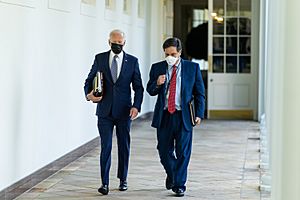
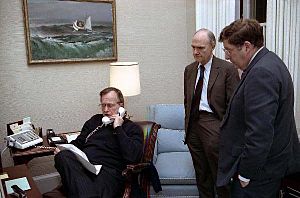

The White House chief of staff is a very important job in the United States government. This person leads the Executive Office of the President of the United States. Think of them as the President's top helper and manager.
The President chooses the chief of staff. This choice does not need approval from the Senate. The chief of staff serves as long as the President wants them to. Every president since Harry S. Truman has had a chief of staff.
As of January 20, 2025, Susie Wiles is the current chief of staff. She works for President Donald Trump in his second term. This role is seen as one of the most powerful jobs in the White House. This is because the chief of staff works closely with the President every day. They also manage the entire Executive Office of the President.
Contents
History of the Chief of Staff Role
Early Presidential Aides
In the past, the President's main helper was called the "private secretary." These secretaries were trusted friends and advisers. They handled both personal and work tasks for the President. They needed to be very skilled and keep things private. Some famous private secretaries were George B. Cortelyou for President Theodore Roosevelt. Others included Joseph Patrick Tumulty for President Woodrow Wilson. Louis McHenry Howe served President Franklin Roosevelt.
The job of managing the President's schedule was separate. This was done by an "appointments secretary."
Growing Government Needs
From 1933 to 1939, President Franklin D. Roosevelt made the government much bigger. This was to help the country during the Great Depression. He relied on a group of top advisers. They were sometimes called his 'Brain Trust'. These advisers worked directly for the President. But they often got paid through other government agencies. This was because the White House did not have a budget for many staff jobs.
In 1939, the White House staff started to become more organized. President Roosevelt convinced Congress to create the Executive Office of the President. This new office reported directly to the President. During World War II, Roosevelt also created a "Chief of Staff to the Commander-in-Chief" role. This was for his main military adviser, Fleet Admiral William D. Leahy.
The Modern Chief of Staff
In 1946, the U.S. government's executive branch grew even more. So, the job of "Assistant to the President of the United States" was created. This was the first step toward the modern chief of staff role. In 1953, President Dwight D. Eisenhower officially named his main assistant the "White House chief of staff."
The title "Assistant to the President" is now shared by many senior aides. This includes the chief of staff, the White House counsel (legal adviser), and the White House press secretary. At first, not all presidents used this new system. Presidents Kennedy and Johnson still relied on their appointments secretaries. It was not until the Nixon administration that the chief of staff took over managing the President's schedule.
This concentration of power led presidential candidate Jimmy Carter to promise something different. In 1976, he said he would not appoint a chief of staff. For the first two and a half years of his presidency, he did not.
How Long Chiefs of Staff Serve
On average, a White House chief of staff serves for about 18 months. John R. Steelman was the first chief of staff under President Harry S. Truman. He was Truman's only chief of staff. Kenneth O'Donnell served for all of John F. Kennedy's time in office. Andrew Card and Denis McDonough each served for a full presidential term. Card worked for President George W. Bush. McDonough worked for President Barack Obama.
What the Chief of Staff Does
Chris Whipple wrote a book called The Gatekeepers. In it, he describes the chief of staff's job. He shared a quote from former President Barack Obama:
During the last days of his presidency, Barack Obama observed: "One of the things I've learned is that the big breakthroughs are typically the result of a lot of grunt work—just a whole lot of blocking and tackling." Grunt work is what chiefs of staff do.
The chief of staff has many important duties. They manage people and give advice. Here are some of their main tasks:
- Choosing important White House staff members.
- Making sure the White House staff works well together.
- Controlling who gets to meet with the President in the Oval Office.
- Managing the information that goes to the President. They also help with decisions made at the Resolute desk.
- Guiding and watching over all new policy ideas.
- Protecting the President's political goals.
- Working with leaders in Congress and other groups. This helps the President's plans become law.
- Giving advice to the President on many different topics.
Sometimes, the chief of staff also has the power to fire senior staff members. For example, John Kelly was chief of staff for President Donald Trump. He told a staff member that his decision for her to leave was final. He said that all staff members work for him, not directly for the President.
H. R. Haldeman was President Richard Nixon's first chief of staff. He was known for being very strict. He often met with government officials instead of Nixon. Then he would tell Nixon what they discussed. Journalist Bob Woodward wrote that many people were afraid of Haldeman.
List of White House Chiefs of Staff
| Denotes acting capacity. |
| Image | Name | Start | End | Duration | President | |
|---|---|---|---|---|---|---|
 |
John Steelman | December 12, 1946 | January 20, 1953 | 6 years, 39 days | Harry S. Truman (1945–1953) |
|
 |
Sherman Adams | January 20, 1953 | October 7, 1958 | 5 years, 260 days | Dwight D. Eisenhower (1953–1961) |
|
 |
Wilton Persons | October 7, 1958 | January 20, 1961 | 2 years, 105 days | ||
 |
Kenneth O'Donnell De facto |
January 20, 1961 | November 22, 1963 | 2 years, 306 days | John F. Kennedy (1961–1963) |
|
 |
Walter Jenkins De facto |
November 22, 1963 | October 14, 1964 | 327 days | Lyndon B. Johnson (1963–1969) |
|
 |
Bill Moyers De facto |
October 14, 1964 | July 8, 1965 | 267 days | ||
 |
Jack Valenti De facto |
July 8, 1965 | June 1, 1966 | 328 days | ||
 |
Marvin Watson De facto |
June 1, 1966 | April 26, 1968 | 1 year, 330 days | ||
 |
James Jones De facto |
April 26, 1968 | January 20, 1969 | 269 days | ||
 |
Bob Haldeman | January 20, 1969 | April 30, 1973 | 4 years, 100 days | Richard Nixon (1969–1974) |
|
| Vacant | April 30, 1973 | May 4, 1973 | 4 days | |||
 |
Al Haig | May 4, 1973 | September 21, 1974 | 1 year, 140 days | ||
| Gerald Ford (1974–1977) |
||||||
 |
Donald Rumsfeld | September 21, 1974 | November 20, 1975 | 1 year, 60 days | ||
 |
Dick Cheney | November 20, 1975 | January 20, 1977 | 1 year, 61 days | ||
| Vacant | January 20, 1977 | July 18, 1979 | 2 years, 179 days | Jimmy Carter (1977–1981) |
||
 |
Ham Jordan | July 18, 1979 | June 11, 1980 | 329 days | ||
 |
Jack Watson | June 11, 1980 | January 20, 1981 | 223 days | ||
 |
James Baker | January 20, 1981 | February 4, 1985 | 4 years, 15 days | Ronald Reagan (1981–1989) |
|
 |
Don Regan | February 4, 1985 | February 27, 1987 | 2 years, 23 days | ||
 |
Howard Baker | February 27, 1987 | July 1, 1988 | 1 year, 125 days | ||
 |
Ken Duberstein | July 1, 1988 | January 20, 1989 | 203 days | ||
 |
John Sununu | January 20, 1989 | December 16, 1991 | 2 years, 330 days | George H. W. Bush (1989–1993) |
|
 |
Samuel Skinner | December 16, 1991 | August 23, 1992 | 251 days | ||
 |
James Baker | August 23, 1992 | January 20, 1993 | 150 days | ||
 |
Mack McLarty | January 20, 1993 | July 17, 1994 | 1 year, 178 days | Bill Clinton (1993–2001) |
|
 |
Leon Panetta | July 17, 1994 | January 20, 1997 | 2 years, 187 days | ||
 |
Erskine Bowles | January 20, 1997 | October 20, 1998 | 1 year, 273 days | ||
 |
John Podesta | October 20, 1998 | January 20, 2001 | 2 years, 92 days | ||
 |
Andy Card | January 20, 2001 | April 14, 2006 | 5 years, 84 days | George W. Bush (2001–2009) |
|
 |
Josh Bolten | April 14, 2006 | January 20, 2009 | 2 years, 281 days | ||
 |
Rahm Emanuel | January 20, 2009 | October 1, 2010 | 1 year, 254 days | Barack Obama (2009–2017) |
|
 |
Pete Rouse Acting |
October 1, 2010 | January 13, 2011 | 104 days | ||
 |
Bill Daley | January 13, 2011 | January 27, 2012 | 1 year, 14 days | ||
 |
Jack Lew | January 27, 2012 | January 20, 2013 | 359 days | ||
 |
Denis McDonough | January 20, 2013 | January 20, 2017 | 4 years, 0 days | ||
 |
Reince Priebus | January 20, 2017 | July 31, 2017 | 192 days | Donald Trump (2017–2021) |
|
 |
John Kelly | July 31, 2017 | January 2, 2019 | 1 year, 155 days | ||
 |
Mick Mulvaney Acting |
January 2, 2019 | March 31, 2020 | 1 year, 89 days | ||
 |
Mark Meadows | March 31, 2020 | January 20, 2021 | 295 days | ||
 |
Ron Klain | January 20, 2021 | February 7, 2023 | 2 years, 18 days | Joe Biden (2021–2025) |
|
 |
Jeff Zients | February 8, 2023 | January 20, 2025 | 1 year, 347 days | ||
 |
Susie Wiles | January 20, 2025 | Incumbent | 342 days | Donald Trump (2025–present) |
|
Related Roles
- Chief of Staff to the Vice President of the United States
- Chief of staff
- Officer of the United States
- Staff and line
- White House Deputy Chief of Staff
See also
 In Spanish: Jefe de Gabinete de la Casa Blanca para niños
In Spanish: Jefe de Gabinete de la Casa Blanca para niños


